#hjúki
Text


Runetober Day 2: Moon
(following the woodland magic prompts by smalltownspells)
In Norse mythology, according to the Prose Edda, a giant once named his children Sun and Moon, because they were as pretty as them. The gods punished that hubris and Sun and Moon (Sól and Máni) have to steer the carriages that pull their namesakes.
Máni has two companions, Bil and Hjúki, two siblings who he picked up when they were fetching water. They still have the pail and the carrying pole with them. Their shadow can be seen on the moon (That´s the craters). The moon is followed by the wolf Hátti who eternally tries to eat it and will eventually succeed at Ragnarök. The runes are two stanzas from Voluspá, where this prophecy is made:
40. In the east sat an aged giantess,
in Ironwood, and there she raised
Fenrir's brood.
Among them
is a certain one
who bites the moon
in a troll's shape.
41. Dead men
feed their lives to the wolf,
the home of the gods
turns red with gore,
the sun shines black
through the summers,
the weather is never cheerful.
Have you learned enough yet?
(Translation by Jackson Crawford)
In the original Old Norse:
40. Austr sat in aldna
í Járnviði
ok fæddi þar
Fenris kindir;
verðr af þeim öllum
einna nokkurr
tungls tjúgari
í trölls hami.
41. Fyllisk fjörvi
feigra manna,
rýðr ragna sjöt
rauðum dreyra;
svört verða sólskin
um sumur eftir,
veðr öll válynd.
Vituð ér enn - eða hvat?
In runes:
:ᛅᚢᛋᛏᛦ·ᛋᛅᛏ·ᛁᚾ·ᛅᛚᛏᚾᛅ:ᛁ·ᛁᛅᚱᚾᚢᛁᚦᛁ:ᚢᚴ·ᚠᚢᚦᛁᚱ·ᚦᛅᚱ:ᚠᛁᚾᚱᛁᛋᚴᛁᚾᛏᛁᛦ:ᚢᛁᚱᚦᚱ·ᛅᚠ·ᚦᛅᛁᛘ·ᛅᛚᚢᛘ:ᛁᛘᛅ·ᚾᚢᚴᚢᚱ·ᛏᚢᚴᛚᛋ·ᛏᚱᛁᚴᛅᚱᛁ:ᛁ·ᛏᚱᛅᛚᛋ·ᚼᛅᛘᛁ:ᚠᚢᛚᛁᛋᛏ·ᚠᛁᛅᚱᚢᛁ:ᚠᛅᛁᚴᛦᛅ·ᛘᛅᚾᛅ:ᚱᚢᚦᛦ·ᚱᛅᚴᚾᛅ·ᛋᛁᚢᛏ:ᚱᛅᚢᚦᚢᛘ·ᛏᚱᛅᚢᛦᛅ:ᛋᚢᛅᚱᛏ·ᚢᛅᛦ·ᚦᛅ·ᛋᚢᛚᛋᚴᛁᚾ:ᚢᛘ·ᛋᚢᛘᚢᚱ·ᛅᛒᛏᛁᛦ:ᚢᛁᚱᚦᚱ·ᛅᛚ·ᚢᚬᛚᚢᚾᛏ:ᚢᛁᛏᚢᚦ·ᛁᛦ·ᛁᚾ·ᛁᚦᛅ·ᚼᚢᛅᛏ:
#mine#my art#runetober#inktober#drawtober#moon#smalltownspells#runes#norse mythology#máni#hjúki#bil#hatti
30 notes
·
View notes
Text
Folklore Fact - Hjúki and Bil / The Man in the Moon / the Bilwis / Jack and Jill
Something different this month - a general folklore fact, rather than a werewolf or vampire fact! It's been a while since I did one of these, so I figured it's high time I toss another one out there.
Ever heard of the Man in the Moon? Of course you have. But have you ever heard of a "bilwis?" What about "Hjúki and Bil?" How about Jack and Jill? And how are all these things actually connected?

Once upon a time, I was playing a video game called Titan Quest with my brother. We ran into a strange creature labeled a Demon that was called a "bilwis." Since the game is based heavily in real-world myth, I decided to look it up. It wouldn't be the first time I encountered an obscure piece of mythology from a video game, that's for sure (the game Age of Mythology helped me get into researching mythology at all, as a child; it's still one of my favorite games).
So first, I looked up a bilwis. A bilwis can be demonic or human and is associated with corn, which would align with what I found in the game, too. They are said to have "flying" hair, are sometimes wrapped in linen, and wear triangular hats. They often appear as whirlwinds to steal grain during harvests. Then I went, wait a minute... that sounds just like Blowhard in the game Spyro the Dragon (also one of my favorite games)!
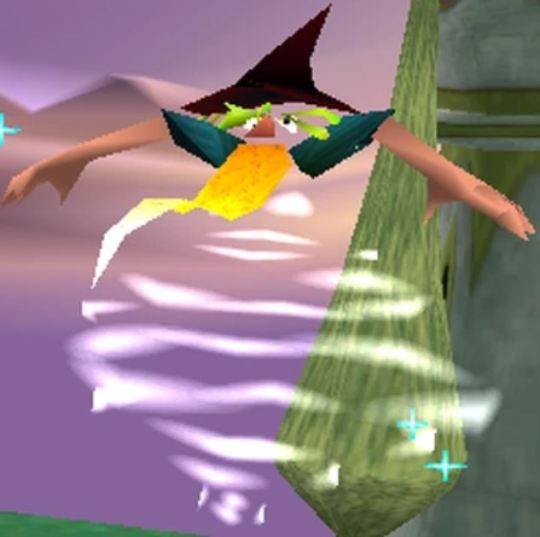
Blowhard is a bilwis! This is OG Blowhard, by the way, not from the remasters. But you should play Spyro sometime. Fantastic games. The remasters are good, too.
Anyway, that fascinated me, because I love learning things like that. But I also found something else... I found a legend called Hjúki and Bil, which was quite the rabbit-hole. Some sources claim the bilwis is related to Bil, which is how I was led here. The bilwis is sometimes said to be a female entity (but it can also be male) and was, at one time, associated with witches - and Bil is interpreted variably to be a kenning for woman, as well as a witch. The connection between Bil and the bilwis only happened in much later time periods, however - so let's go back to the original story of Hjúki and Bil.
The tale of Hjúki and Bil comes from Norse mythology. Their names are said to mean "the one returning to health" and "instant," respectively, though scholars apparently can't entirely confirm that first one. They are brother and sister, a pair of children who follow the moon across the heavens. We know about them because of - you guessed it - Snorri Sturluson's Prose Edda. There are a lot of theories around these two, but they were said to have been a pair of children, both carrying a pole on their shoulders (the pole was called Simul) and held a pail called Sæg between them. But the children were taken by Mani (the moon) from the earth, to follow the moon forever in the heavens, and "can be seen from the earth."
It is possible that Hjúki and Bil represented the waning and waxing of the moon - or they may have even represented the craters on the moon. Scholars argue about it a lot, but many of them present compelling arguments that Hjúki and Bil were the craters, which were interpreted as children with a water pail between them on a stick.
Similar modern folklore from the same regions sees the Man in the Moon as a man with a pole, often carrying wood (or else stealing it and stuck in the moon as punishment), and sometimes with a woman with a bushel. This lends more credence to the idea of Hjúki and Bil being connected to the moon - and people in the moon.
There is another connection - one with Jack and Jill, the famous nursery rhyme...
You may have already noticed some similarities to the story of Hjúki and Bil and Jack and Jill - even their names sound similar! Both stories are about two children, one boy and one girl, who fetch a pail of water.
For those of you who need refreshing on the rhyme...
Jack and Jill went up the hill
to fetch a pail of water
Jack fell down and broke his crown
and Jill came tumbling after.
Up Jack got and home did trot
as fast as he could caper.
He went to bed to mind his head
with vinegar and brown paper.
The origins of many elements of folklore, mythology, nursery rhymes, fairytales, and all their kind are always mysterious and fascinating. It's entirely possible that Hjúki and Bil are directly related to Jack and Jill, and that the latter is a retelling of the original Norse tale - and that the story of Jack and Jill fetching the pail represents the waning and waxing of the moon or the craters on the moon that we can see easily from Earth.
That covers a decent overview! There is of course a lot to all these things, as you might imagine, but I chose this time to focus on informing you about the existence of Hjúki and Bil and the bilwis at all, rather than getting deep into the debate and "conversation" around all these matters.
Until next time, and have a wonderful November (and happy Thanksgiving)!
( If you like my blog, be sure to follow me here and elsewhere for more folklore and fiction, including books, especially on werewolves! You can also sign up for my free newsletter for monthly werewolf/vampire/folklore facts, as well as free fiction and nonfiction book previews.
Free Newsletter — maverickwerewolf.com (personal site + book shop) — Patreon — Wulfgard — Werewolf Fact Masterlist — Twitter — Vampire Fact Masterlist — Amazon Author page )
#folklore#folklore fact#Hjúki and Bil#man in the moon#moon#mythology#norse mythology#norse myth#folklore thursday#folklorethursday#legends#myths and legends#harvest#demon#demons#bilwis#spirits#jack and jill#nursery rhymes#spyro#blowhard#spyro the dragon#titan quest#video games#video games can be educational occasionally
10 notes
·
View notes
Text

oh god… he has children…
Hjúki & Bil! [absolute chaos ensues]
So, Máni may or may not have lowkey kidnapped two kids while they were going to get water, and took them into the sky to follow him around? Yea i like to think their father was shitty so its justifiable but Máni doing it “just because” is funnier-
so they’re honorary kids! adopted!
[now i can post OC memes i’ve made MWUAHAHHAHA-]
#gow#god of war#god of war ragnarok#gow oc#god of war oc#Hjúki & Bil#Hjuki & Bil#they’re literally the same person besides gender-#which makes a lot of- chaos- happen-#their dad loves them though so it’s ok#my art#staymauy
10 notes
·
View notes
Text
#1 Milo Elden pt4
Ezért azt teszem, amihez a legjobban értek. Megvédem őt és biztosítom a lehetőségét annak, hogy a lovarda fent maradjon és mindig legyen itt nyüzsgés. Jól gondolod, hogy akárcsak régen, most is Sol dicsőségét felhasználva „reklámozom” a lovardát a midgardiaknak. Azok, akik nála kezdenek el tanulni, olyanok, mint a csillagok, akiket az éjszakában az ő „szikráiból” formáltam. A csillagok azokat nyűgözték le, akik felpillantottak az égre és a szabadságra vágytak vagy az ismeretlen felé húzott a szívük, a valahová tartozás vágya felé. Valami ilyesmi történik akkor is, amikor az egyik közösségi médiára „véletlenül” felkerül egy poszt az egyik sikeres versenyről és versenyzőről, akit Sol készített fel. Mondanám, hogy az éjszakai égbolt reklámozása csak a kezdet volt és most sem fog ez másképpen lenni a lovardával kapcsolatban sem. De azt semmiképpen sem akarom, hogy ez akár olyanoknak is feltűnjőn akik szimatot foghatnak. Ezért vagyok óvatos, mert attól, hogy itt vagyunk a rémálmok nem szűntek meg.
Bár azt kell, hogy mondjam sikerült egész jó kis csapatott összeverbuválni itt, Sol mellett nem csak én vagyok és azok a gyerekek, akiknek a sorsáról megfogadtam, hogy gondoskodni fogok, hanem Lune és Ubbe is, a recepciósunk és az egyik lovász, aki Sol-nak segít. A „gyerekek”, akik már nem is olyan kicsik Bil és Hjúki nekem segítenek. Elég értelmesek és jobban szót értenek a fiatalokkal, mint én. Ami a számomra pont kapóra jön, mert megragadhatjuk az érdeklődésük lényegét és ezt kihasználva valami olyasmit nyújthatunk nekik amire vágynak, természetesen akkor hogyha az a lovaglással és lovakkal kapcsolatos. Egy hitetlent nem fogok tudni megtéríteni én sem, akármilyen isteni erőm is legyen. DE itt jön a csavar az egészben! Ha ennek a csodálatos kételkedőnek van egy kislánya, vagy kisfia, aki bolondul a pónikért, hát nagy meglepetésére nem akármilyen pónikra ültetheti fel a lányát, fiát! Az én lovaim, Skuggi (árnyék) és Skundi (sebesség)* itt Midgardban csodás kis pónik formájában trappolnak a kíváncsi kisgyerekek elé.
Spoiler:
*1. Mani lovai eredetileg nincsenek megnevezve, ezért kerestem nekik én valamit.
0 notes
Text



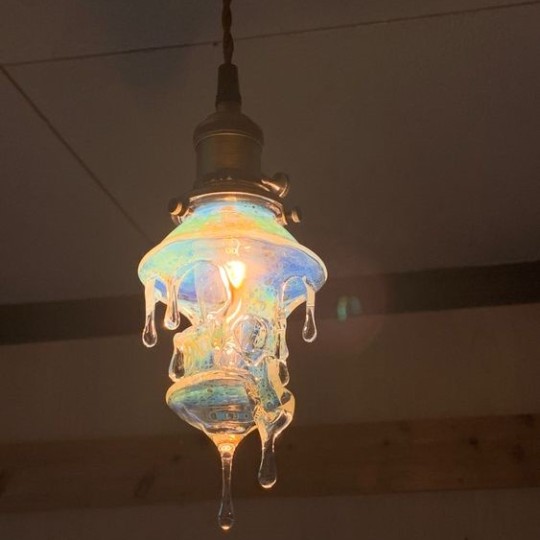



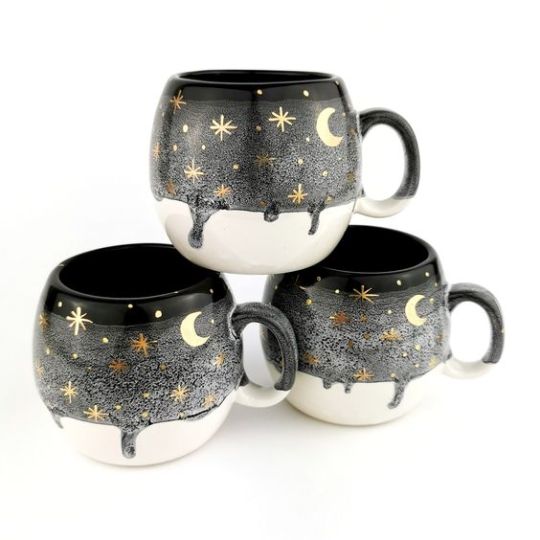

BILWIS ‘BIL’, nineteen (immortal)
ALIAS | n / a
FAMILY | Viðfinnr (father), Hjúki (twin bother), (siblings tba); attendant of Máni and Sunna
ENDGAME SHIP | Dolores Lopez
ORIENTATION | bisexual, cis woman
POWERS / ABILITIES / EQUIPMENT
POWERS | Allspeak, Enhanced Senses, Healing Factor, Longevity, Self Sustenance, Superhuman Durability, Superhuman Speed, Superhuman Stamina, Superhuman Strength (via Asgardian Physiology), Darkness Manipulation, Gravity Manipulation, Light Manipulation, Lunar Embodiment, Lunar Empowerment, Lunar Manipulation, Night Manipulation, Reflection Manipulation (via being a goddess associated with the Moon)
ABILITIES | Dagger Proficiency, Hand-to-Hand Combat (Basic), Magic
EQUIPMENT | n / a
FACECLAIM | Alaina Castillo
PINTEREST | Bil
NOTE
is one of the personification of the phases of the moon
1 note
·
View note
Text


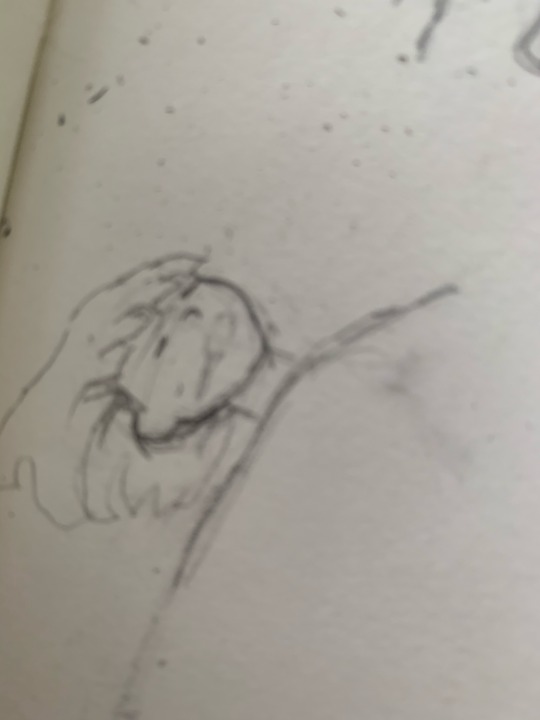
This is Hjúki from Norse Mythology. I did some digging to find some stuff about him but there wasn’t a lot. I loved his name! I was deciding which character I’d go for: a character named after him or just Hjúki himself. I settled for the character himself and thought of a little story for him.
Máni put Hjúki inside an orb of some sort. After Ragnarok and hundreds and hundreds of years later, he woke up in a field (in the 13th century) to which he recalls that he doesn’t remember exactly how he got to where he is now. He soon discovers that Bil and Máni didn’t survive Ragnarok, which caused him to break down. Unaware, he has a superpower that makes him time travel when he’s at his weakest. All he has to do now is survive on his own.
I hope you like my concept for his story!
3 notes
·
View notes
Text
Tags for stuff about Finny
Just check out the tags below.
Reblogging this post is not very useful, even if you include the current tags. Instead, just navigate back to it from the pinned post at the top of the blog.
3 notes
·
View notes
Text
Today’s “Legit” Finny Name Suggestion is…
Hans or Hansel
“Because that’s a German equivalent to Jack, and I theorize he’s a parallel to Jack from the story of Jack and Jill, or Hjúki and Bil… the brother and sister who follow Máni, the personified moon in Norse mythology.”
Blessed by @abybweisse
#black butler#kuroshitsuji#finny#finnian#legit suggestion#abybweisse#blessed status#hans#hansel#jan 31 2022
25 notes
·
View notes
Note
Haila! Glad to see you're still active, I hope you've been well and full of good health. I had a few questions you may be able to help with. Linguistically or loreically, are any of the Norse Deities, Loki, Sigyn, Odin, Skadi, etc associated with celestial bodies such as stars or planets? Additionally do we know if there are gothic versions or variants or chunks of the norse sagas? I'm slowly beginning to study gothic and my interests are overlapping!
Other than the obvious ones (Sól, Máni), there are some beings who are associated with Sól and Máni but who are sort of ambiguous: Mundilfari, Hjúki, Bil. Hjúki and Bil probably have something to do with the moon and Mundilfari probably serves some kind of role in the cosmos though it isn't entirely clear what it is.
Snorri recounts a story about Þórr saving the life of Aurvandill but his toe becoming frozen, so Þórr snaps it off, hurls it into the sky, and turns it into the star Aurvandils tá 'Aurvandill's toe.' The Cleasby-Vigfússon dictionary suggests that this is the star Rigel but it's not clear why, and is marked with a (?).
In another story, either Þórr or Óðinn threw the eyes of Þjazi, the father of Skaði, into the sky and made them into stars. It seems likely to me that these were two stars in particular, but I don't think it's known which ones.
According to Finnur Magnússon in 1828, Lokabrenna 'Loki's burning' was a name for the star Sirius.
It's said that Ursa Major was at one point called Óðins vagn 'Óðinn's wagon.' I have no idea whether that's true or what the evidence for it is. From what I gather this is a continental Germanic folklore thing that was sort of back-projected into Old Norse.
The name Friggjarstjarna 'Frigg's star' is used for the planet Venus in Clements saga in a manuscript dated to about 1220. It's not clear whether this is a common vernacular name for it or whether the author was doing some interpretatio romana on the fly, as the saga makes extensive use of that device ("translating" Roman deities into Norse ones, having St. Clement denounce the Norse gods rather than the Roman ones as in the original).
According to Jacob Grimm, there are also a widely distributed set of names for Orion's belt in Scandinavia describing it as "Frigg's distaff" or "Freyja's distaff." I know Grimm is very much out of favor among most modern heathens but if this is just raw data collection it's still useful.
Týr is sometimes associated with stars or constellations such as the North Star though association with the Old English rune Tir. The OE Rune Poem entry for Tir reads (trans. Halsall 1981):
Tir is one of the guiding signs; it keeps faith well
with princes; always it holds its course
above the night-clouds; it never fails.
If Friggjarstjarna for the planet Venus was a vernacular term, we might reason that the other planets could be associated with gods the same way that the days of the week were. That would give us Mercury : Óðinn, Venus : Frigg, Mars : Týr, Jupiter : Þórr. This scheme is actually West Germanic, not Norse (not to mention nearly a thousand years old by the time of the sagas). The Norse word for 'Friday' is frjádagr which points to a West Norse cognate of Frigg, something like Frīa, and Norse texts seem to show a bit of confusion as to whose day that was supposed to be because the etymological link between Frīa and Frigg was presumably not transparent to them (any more than to modern non-specialists; I've seen quite a few heathens declare Friday to be "Freyja's day" which is wrong etymologically but the mistake itself is tradition at this point). Among Norse translators of Latin texts Venus was more likely to be equated with Freyja than with Frigg.
As far as Gothic goes, something like 95+% of the Gothic that exists is the Bible and commentary on the Bible. There really couldn't be Gothic analogues to the Icelandic sagas because extremely little of what is described in the sagas, even the legendary sagas of "ancient times," hadn't happened yet when the vast majority of our evidence for the Gothic language was being written (i.e., yeah, the Gothic language persisted through the Hunnic invasions and stuff, but that stuff wasn't written down in Gothic or if it was it wasn't preserved). The heyday of written Gothic is the 4th century; the heyday of the sagas is the 13th-14th centuries. You'll surely want to look into the Gothic Roman historian Jordanes, but he wrote in Latin. It really can't be emphasized enough just how old written Gothic is. It's probably even older than most Elder Futhark runic inscriptions (despite the latter seeming to be in a less advanced state of development in some ways).
81 notes
·
View notes
Video
youtube
Und hier ist es, mein etwas trashiges Musikvideo für @finn-thorsons “Intimate Exploration”. Ich dachte, es passt hervorragend zu einer Kurzgeschichte aus Hjúki Himas “Escape: 701″.
Die Idee zu diesem Video hatte ich bereits Anfang 2015, aber erst jetzt, da ich in Karem eine bereitwillige Schauspielerin gefunden habe, konnte ich das Projekt auch in die Tat umsetzen. Vielen Dank dafür Karem!
Es ist alles sehr amateurhaft, da ich weder Kamera noch Schnitt gelernt habe und nur improvisierte Technik (siehe hier) besitze. Aber trotzdem gefällt mir das Ergebnis sehr gut. Ich hoffe, euch auch.
PS: Ja, das Yellow Submarine ist ein 100-prozentiges MoC, wenn es auch stark an die Originale der damaligen Lego-Taucherreihe angelehnt ist, aus deren Teilen es besteht.
3 notes
·
View notes
Text
Hail Máni
Hail to the Old Man in the Moon
Hail to the Guardian of Hjúki and Bil
Hail to the Waxer and Waner
Bless and walk with us this day
8 notes
·
View notes
Text
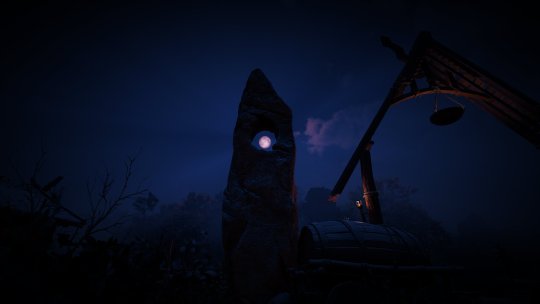

Twelve Days of Valhalla God 7: Máni
Máni is the Moon personified in Germanic mythology.
... sources state that he is the brother of the personified sun, Sól, and the son of Mundilfari, while the Prose Edda adds that he is followed by the children Hjúki and Bil through the heavens.
I wanted to take a picture similar to "The Eye of God" rock formation found in the Prohodna caves. Also I shall shoot the moon.
#ac photo mode#ac valhalla#assassin's creed valhalla#assassins creed valhalla#twelve days of valhalla
5 notes
·
View notes
Photo
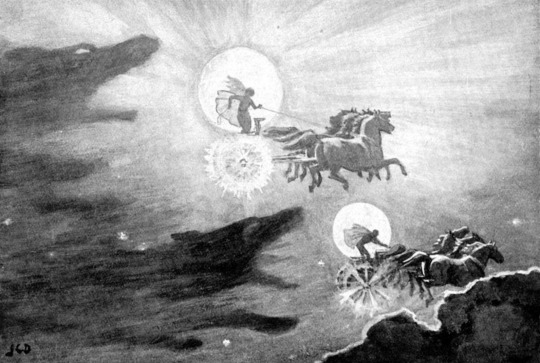
The Wolves Pursuing Sol and Mani” (1909) di J. C. Dollman
Sól e Máni erano fratello e sorella e avevano il compito di guidare rispettivamente il carro del sole e il carro della luna. In principio non erano due divinità, ma due giganti, figli di Mundilfoeri, che aveva voluto dare loro il nome di sole e luna per vanto. Il gigante stravedeva talmente per i suoi figli che aveva poi deciso di dare Sól in sposa al dio Glenr, dio delle nuvole o del cielo. Per punire tale orgoglio, gli dèi decisero di affidare a Màni il carro della luna e a Sòl il carro del sole, che avrebbero dovuto guidare per metà del giorno inseguiti da due lupi: Màni era inseguito da Hati, Sól da Sköll. Si diceva che questi due lupi sarebbero riusciti a raggiungerli e a divorarli durante il Ragnarök, la fine del mondo, ma i loro figli sarebbero riusciti a sopravvivere ai genitori. Con questo mito veniva spiegato anche il verificarsi delle eclissi: si diceva che le eclissi di luna avvenissero quando Hati era vicino a divorare Máni, coprendo parte della luce lunare che arrivava sulla Terra, mentre quelle di sole quando Sköll era vicino a divorare Sól. Màni aveva due servitori, anch’essi fratelli e sorella: Bil e Hjúki, che erano due mortali, figli di un certo Vidfinnr, che il dio aveva preso con sé dalla terra. Questi due bambini rappresentavano le macchie lunari, ma è possibile che fossero anche considerati i responsabili delle fasi lunari. Il mito racconta che i due fanciulli tenevano sempre con loro un secchio d’acqua (chiamato in norreno Sægr), responsabile delle maree, poiché si diceva che fossero stati prelevati dagli dèi mentre tornavano coi due secchi pieni dalla fonte Byrgir.
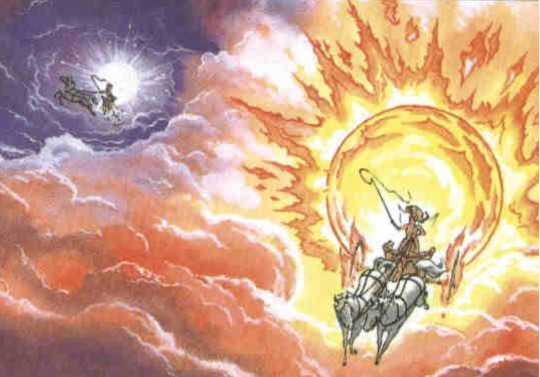
«Hár segir: « Sá maðr er nefndr Mundilfœri er átti tvau börn.
Þau váru svá fögr ok fríð at hann kallaði annat Mána en dóttur sína Sól,
ok gipti hana þeim manni er Glenr hét.
En guðin reiddusk þessu ofdrambi ok tóku þau systkin ok settu upp á himin, létu Sól keyra þá hesta er drógu kerru sólarinnar, þeirar er guðin höfðu skapat til at lýsa heimana af þeiri síu er flaug ór Muspellsheimi. Þeir hestar heita svá: Árvakr ok Alsviðr. En undir bógum hestanna settu guðin tvá vindbelgi at kœla þá, en í sumum frœðum er þat kallat ísarnkol. Máni stýrir göngu tungls ok ræðr nýjum ok niðum. Hann tók tvau börn af jörðunni er svá heita: Bil ok Hjúki, er þau gengu frá brunni þeim er Byrgir heitir ok báru á öxlum sér sá er heitir Sœgr, en stöngin Símul. Viðfinnr er nefndr faðir þeira. Þessi börn fylgja Mána, svá sem sjá má af jörðu.»»
«Hár disse: «Un uomo che si chiamava Mundilfœri ebbe due figli.
Essi erano così belli e gentili che egli chiamò suo figlio Máni e sua figlia Sól e diede questa in sposa a quell'uomo che si chiamava Glenr.
Ma gli dèi si adirarono per questa insolenza, presero i due fratelli e
li posero in cielo, costringendo Sól a cavalcare quei cavalli che tirano
il carro del sole, che gli dèi avevano creato per illuminare il mondo con quella favilla che era sfuggita dal Múspellsheim.
Quei cavalli si chiamano Árvakr e Alsviðr, sotto le cui spalle
gli dèi hanno messo due otri di vento per rinfrescarli, che in qualche cronaca sono dette ísarnkol. Máni dirige il corso della luna e governa le sue fasi.
Egli prese dalla terra due fanciulli, chiamati Bil e Hjúki, mentre si allontanavano dalla fonte chiamata Byrgir e portavano sulle loro spalle il secchio chiamato Sægr e il bastone Simul. Viðfinnr si chiama il loro padre.
Questi fanciulli seguono Máni, come si può vedere dalla terra.»»
Snorri Sturluson - Edda in prosa -Gylfaginning XI
1 note
·
View note
Note
Hello! I was wondering if you know much about nott and mani, and if you would be willing to tell me some things about them! I am only just getting into this stuff and I haven't connected to any kind of deity before, but these two are connected to things i like.
Pretty much all of what I “know” is UPG so the usefulness of this to you will be subjective, but hopefully it’ll be of some use…
So to start, what is known? Or - as I would consider to be more accurate - what is recorded in the existing texts? In the Poetic Edda both Máni and Nótt are mentioned, albeit passingly: From Vafthrúdnismál (23rd stanza) we are told via a conversation between Odin and Vafthrúdnir that Mundilfari is the father of both Máni and Sól who turn in the sky each day so that people can count the years. Again from Vafthrúdnismál (25th stanza) we are told via the same conversation that Nótt is the child of Nör, and along with Dag is responsible for new moon and the tides so that people can tell time. So pretty much what you’d expect to be said about the deific personifications of The Moon, and Night so far haha
Moving on now to the Prose Edda, Snorri expands on these introductions in Gylfaginning…
Máni: Snorri states that Mundilfari was a man who had two children so beautiful that he named them Máni and Sól. The gods perceived this as hubris on his part (and yes, I am purposefully drawing attention to the potential Greek influence/parallel here) and decided to punish him by banishing his children to the sky to serve (as?) the celestial bodies for which they were named, Máni controlling the movement, and waxing and waning of the moon. Two human children, Bil and Hjúki, are said to have been taken up from Midgard by him to accompany him in the sky, it is also said that he will be consumed by Mánagarm at Ragnarök.
Nótt: Snorri states that Nótt is the child of the jotun, Nörfi. She has a string of marriages; first Naglfari (their child is Aud), second Ánar (their child is Jörd), third Delling (their child is Dag). Odin is said to have given Nótt and Dag horses so that they could be drawn across the sky in wagons, Nótt’s horse being named as Hrímfaxi whose spit is claimed as the source for dew (this is also claimed in Vafthrúdnismál)
Now for my personal thoughts:
Máni: I don’t have all that much to add on Máni, really - my perception/understanding of him is that he’s peaceful, hopeful, protective in an unaggressive manner, longing, comforting, a patron of good dreams, strengthening to the mind and spirit, connected with silver, and magic, and love.
Nótt: If you’re familiar with the Daedric Prince, Nocturnal from the Elder Scrolls games then you have a fair idea of my perception of Nótt (I already perceived Nótt in those ways, I just made the connection after playing Skyrim) she’s Calm but in a quasi-foreboding manner, like, she’s chill in general but also doesn’t need to display how dangerous she (potentially) is because she just is. She’s enveloping, either like a loved-one’s embrace or a death-shroud. She is alluring, and she is cautionary. She’s a patron of mystery, secrecy, thievery, luck, fear, imagination, dreams, sleep, nocturnal activities and animals, conspiracy and plots, connected with all darkness and shadows, and wishes.
And finally here are the links to the pieces I’ve written for Máni and Nótt
Again, I hope this is helpful to you anon :)
Seel!
65 notes
·
View notes
Text
#1 Milo Elden pt2
Egyszer el is ígértek minket valakinek és amikor úgy tűnt, hogy az irányításunk kicsúszik a kezükből és valami jöttment kezébe kerülünk galád módon „megtréfálták” az illetőt. De legalább hatalmas védőfal veszi körül Asgardot ennek köszönhetően. Szóval minden rosszban van valami jó. Csak észre kell venni azt. Nekem is sikerült. Már nem háborogtam annyit magamban.
Hogy csökkentsék a népszerűségemet terjeng valami ócska elrablásos história is rólam. Pedig egyáltalán nem raboltam el senkit sem, hanem megmentettem őket. Igen, megmentettem azt a szerencsétlen testvérpárt (Hjúki-t és Bil-t) az apjuk (Vidfinnr) verésétől és valamilyen szinten a haláltól is. Sokat éheztek és sokat is dolgoztak, folyton vizet kellett hordaniuk. Az egyikük mindig nagyon ügyetlen volt és az ő vizes edénye folyton semmivé lett, mert megbotlott és ezzel a földet öntözte vele. De a másikuk mindig ügyesebb volt, tele edénnyel cipelte a vizes terhét. Ettől függetlenül mindketten ugyanannyi verést kaptak, mert az egyik nem vigyázott a másikra és az egy mindenkiért mindenki egyért elvet betartva… szenvedtek maradjunk annyiban. Ezek a gyerekek úgy éreztem olyanok, mint Sol és én. Az egyikünk az ügyesebb a másik pedig az ügyetlenebb, akinek szüksége van a testvérére. Persze, hogy nem az eszemre hallgattam és megsajnáltam őket. Ezért egy éjszaka amikor vízért küldték őket a Byrgir kúthoz szépen elragadtam őket és felültettem őket a Hold szekerére.
Féltek. Persze, én is féltem. Ekkora hülyeséget azóta se csináltam és nem is fogok. De elmondtam nekik, hogy nem fog bántódásuk esni és hogyha segítenek nekem, akkor örök megbecsülés vár rájuk. Azt persze elfelejtettem hozzá tenni, hogy ennek köszönhetően életük végéig – ami sosem fog eljönni – engem kell szolgálniuk vagy, hogy egészen pontos legyek a Holdat. Így pedig nekik köszönhetően a Hold „megtelik” és szépen lassan „elfogy” az égbolton. Ők ketten a Hold fázisai és egyáltalán nem számít, hogy ügyetlenek vagy ügyesek, mert beillenek az idő körforgásának rendszerébe. Valószínűleg sosem bocsátják meg nekem, hogy ebbe kevertem őket, de túl magányos voltam és hiányzott a gyerekveszekedések zaja. A feladatom miatt nem akartam magamnak családot, ezért ők ketten lettek az én családom, amit nem a vér köt össze, hanem a sors. Szóval, ha legközelebb gyerekrablónak titulálnál gondolj csak bele mennyi mindent köszönhetsz most Nekem! Nem kell minden éjszaka ugyanazt nézned az égbolton, hanem van valami kis változás is.
Évszázadok teltek el így. Békességben. Vagy legalábbis én úgy éreztem, amíg be nem következett az a szörnyű jóslat és meg nem jelentek azok a bestiák a nyomunkban. Ha eddig nyugodt életünk volt, akkor az istenek megint beleköptek a Nap és a Hold levesébe és olyan pokolfajzatokat szabadítottak ránk, amik szomjaztak ránk és az erőnkre. Sosem békéltem meg azzal, hogy vad farkaskölyköket szelídítsünk meg és tegyünk úgy, mintha valami házikedvenc lenne. Már akkor nem örvendtem Loki gyerkőceinek, amikor még csak kis semmirekellők voltak, hát még azután, hogy a leszármazottjaik közül kettő kifejezetten minket akar. Őket nem csupán a bosszú hatja. Ha így lenne már régen feladták volna a próbálkozást. A csillapíthatatlan vérszomjuk az, ami olyan kitartásra sarkalja őket, amire példa még nem volt. Sosem fáradnak, sosem veszítik el a nyomunkat, mert mindig ránk találnak.
Az egyiküknek tűzvörösen izzó szeme van, a másiknak pedig jeges kék. Legalábbis az álmaimban azt látom, hogy eljönnek értünk és örök lesz a sötétség. Persze nem tudni pontosan mikor, de a nyomomban érzem őket anélkül is, hogy nem látom őket, elég, ha a jelenlétüket érzem. Az álmaim mostanában mindig ugyanúgy kezdődnek és ugyanúgy végződnek. Valaki felébreszti a szunnyadó óriás farkasokat, mormol nekik valamit és egy bűvös nyílvesszővel miután a farkasok felébredtek és bekövetkezett a napfogyatkozás az illető tétovázik. Még nem akarja megfeszíteni a húrt, pedig ez a sorsa. A farkasokra néz, erőt vesz magán és céloz.
0 notes
Text
Awsten Knight as a Demigod
[please feel free to come talk to me about this]
Awsten Knight, Son of Mani
- Mani is the moon in Norse mythology and he's said to be the one that counts the years and also that he's being chased by Hjúki and Bil, two giant wolves that chase him through the skies so that they may eat him (another part of Ragnarök)
- Awsten is bright and practically nocturnal, is unfortunately basically a magnet to wolves, and incredible at math/instinctively knows what time it is/how much time has passed
- he's also forever cold
- he's loud and false-arrogant (he pretends to have an ego) to make up for his insecure and naturally submissive behaviour like he hates violence and fighting and thinks that conflict should be solved through debate instead of war
- he loves mondays (that's just cute bc mondays are named after the moon/Mani)
- like Ashton, Awsten is also terrified of wolves but he has never bother to hide it
- he is fiercely protective over those around him and though he can come across as high energy and intense, he’s actually very chill and calming to be around
1 note
·
View note